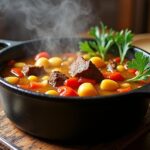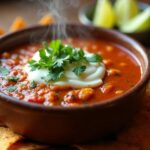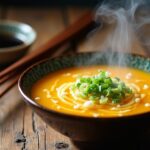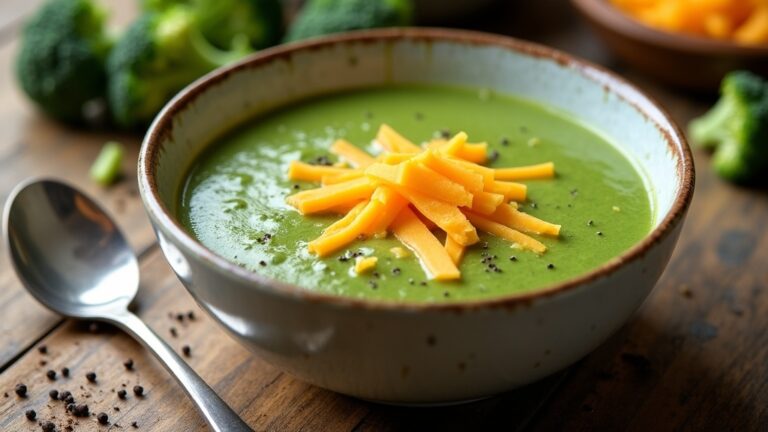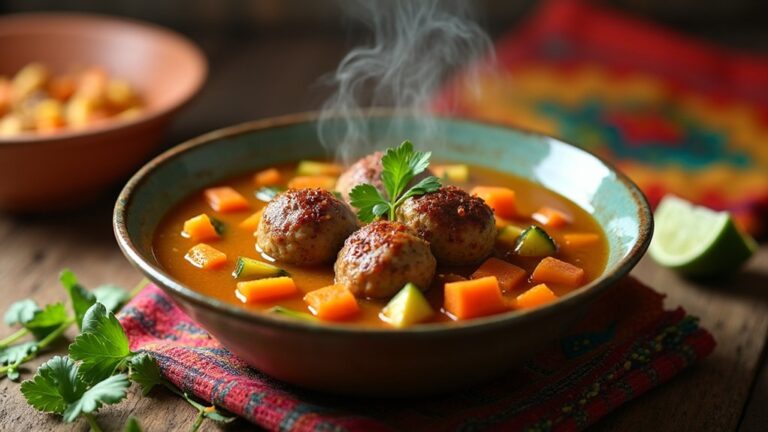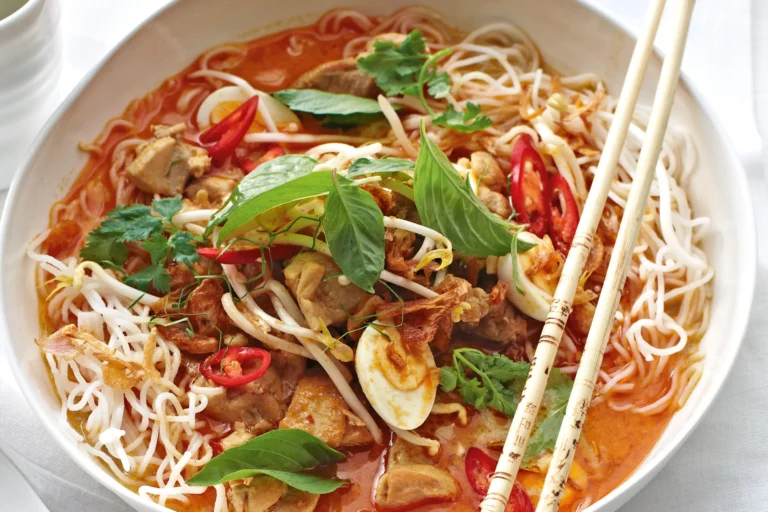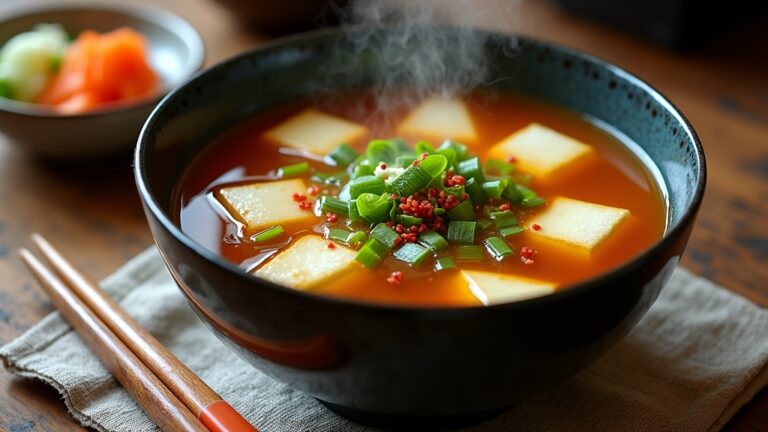Pepper Soup Recipe
Pepper soup is a vibrant dish from West Africa that’s filled with warmth and flavor. I love how it’s perfect for gatherings or a comforting remedy during chilly nights. You can make it with chicken, fish, or goat, and spice it up with ingredients like ginger, garlic, and peppercorns. The aroma while it simmers is simply irresistible! If you’re curious about how to prepare the perfect pepper soup and its nutritional benefits, there’s so much more to explore!
Contents
History
When I think about the rich history of pepper soup, I can’t help but feel a deep connection to its roots in West African culture. This dish isn’t just a meal; it embodies a vibrant tapestry of traditions and stories passed down through generations. Its cultural significance is profound, often served during celebrations, healing rituals, or family gatherings, symbolizing community and togetherness. What fascinates me is the regional variations that pepper soup boasts—each area infusing its unique spices and ingredients, reflecting local flavors and customs. For instance, some might use fish, while others prefer goat or chicken, showcasing the diversity of West African cuisine. This adaptability not only highlights innovation but also honors the shared heritage of the people.
Recipe
Pepper soup is a beloved dish in many cultures, particularly in West Africa, known for its spicy and aromatic flavor profile. It is often enjoyed as a comforting meal during colder months or as a remedy for colds. This soup is versatile and can be made with various proteins such as chicken, fish, or goat meat, making it a favorite choice for gatherings and celebrations. The key to a delicious pepper soup lies in the unique blend of spices and the freshness of the ingredients.
A beloved West African dish, pepper soup offers a spicy, aromatic delight perfect for comfort and gatherings.
Making pepper soup is not only simple but also allows for creativity regarding flavor. This dish can be served as a starter or a main course, depending on the serving size and ingredients used. The broth is typically light yet packed with flavor, making it perfect for those who enjoy a spicy kick. Pair it with a side of rice or plantains for a complete meal that’s sure to satisfy your taste buds.
Ingredients:
- 1 kg of chicken (or your choice of protein)
- 1 medium onion, chopped
- 3-4 cups of water
- 2-3 tablespoons of ground pepper (or to taste)
- 1 tablespoon of ground crayfish
- 2-3 tablespoons of pepper soup spice mix
- Salt to taste
- 2-3 sprigs of fresh basil or scent leaves
- Optional: 1-2 tablespoons of palm oil for added richness
To prepare the pepper soup, start by rinsing your protein of choice thoroughly. In a large pot, combine the chicken, chopped onion, and water, then bring to a boil over medium heat. Allow it to simmer for about 15 minutes, skimming off any foam that rises to the surface. Next, add the ground pepper, crayfish, pepper soup spice mix, and salt to the pot. Let it continue to simmer for an additional 20-30 minutes until the meat is tender. Just before serving, stir in the fresh basil or scent leaves and, if desired, add palm oil for extra depth of flavor.
When cooking pepper soup, feel free to adjust the level of spices to suit your taste preferences; some may prefer it milder while others enjoy it extra spicy. Additionally, for a richer flavor, you can marinate the protein in your chosen spices for a few hours before cooking. If you prefer a clearer broth, strain the soup before serving. Serve hot, and don’t forget to have some side dishes ready to complement this delightful pepper soup!
Cooking Steps
Now that we’ve gathered all the fresh ingredients, it’s time to bring the flavors together. I love adding spices and seasonings that really make the soup pop, then letting it simmer for a cozy 30 minutes. Once that’s done, straining the mixture is the final touch before serving it hot with a beautiful garnish.
Step 1. Gather Fresh Ingredients
As I step into the kitchen, the aroma of fresh herbs and spices fills the air, igniting my enthusiasm to gather the essential ingredients for a delicious pepper soup. I always start my ingredient sourcing at local markets, where vibrant produce beckons. The lush greens of fresh basil, the fiery red of ripe peppers, and the earthy undertones of ginger create a colorful palette. I love engaging with vendors, asking about their harvest, and picking the best quality. Each ingredient tells a story—organic, locally sourced, and bursting with flavor. I select tender meats and fresh fish, ensuring they complement the soup’s rich broth. With my basket full, I’m ready to create a pepper soup that celebrates freshness and innovation.
Step 2. Add Spices and Seasonings
Once I’ve gathered my fresh ingredients, the next step is to elevate the flavor profile by adding a symphony of spices and seasonings. I start with a bold blend of peppercorns, ginger, and garlic to create a robust foundation. Then, I experiment with different spice combinations, perhaps adding coriander for a citrusy zing or thyme for earthy depth. The key is to balance heat and aroma, ensuring each seasoning technique enhances the dish without overpowering it. I sprinkle in a pinch of salt to draw out the flavors, and if I’m feeling adventurous, a dash of cayenne for an extra kick. Each addition transforms the broth into a fragrant masterpiece, setting the stage for a truly memorable pepper soup.
Step 3. Simmer for 30 Minutes
I usually let the mixture simmer gently for about 30 minutes, allowing the flavors to meld together beautifully. This step is essential for developing rich broth flavors that will elevate your pepper soup to new heights. I love experimenting with different simmer techniques to guarantee every ingredient shines.
- The aroma fills the kitchen, a tantalizing invitation.
- The spices infuse, creating a harmonious blend.
- A taste test at the halfway mark can guide adjustments.
- Keep the heat low to avoid boiling; a gentle simmer is key.
- Don’t rush; patience rewards you with depth and complexity.
After 30 minutes, you’ll find the broth transformed—ready to impress anyone lucky enough to savor it!
Step 4. Strain the Soup Mixture
After the simmering ritual, it’s time to strain the soup mixture, an essential step that guarantees a silky, smooth broth. I grab my fine mesh strainer, a kitchen tool that’s become my best friend in achieving perfect soup clarity. Carefully pouring the mixture, I let the rich liquid flow through while the spices and herbs are left behind. This straining technique not only removes any grit but also enhances the overall flavor profile by allowing the aromatic essence to shine through. If you’re feeling adventurous, you can even layer a cheesecloth for an extra level of refinement. Trust me, taking the time to strain will elevate your pepper soup to an entirely new dimension, making each sip a delightful experience.
Step 5. Serve Hot With Garnish
As the aroma of the freshly strained pepper soup fills the air, it’s time to serve it hot, ensuring every bowl captures that inviting warmth. I love to elevate my dish with a few creative garnish options that not only enhance the flavor but also add a visual appeal. Here are some serving suggestions that will impress your guests:
- Fresh cilantro or parsley for a burst of color
- Sliced jalapeños for an extra kick
- Diced onions for crunch and zest
- A drizzle of coconut milk for creaminess
- Lime wedges to brighten the flavors
Each of these garnishes brings something unique to the table, transforming a simple soup into an extraordinary culinary experience. Enjoy every flavorful sip!
Nutritional Guide
Pepper soup, a delightful and warming dish, is not only a feast for the senses but also packs a nutritional punch. I love how this dish combines various ingredients that contribute to its impressive health benefits and nutritional value. The spices used can aid digestion and boost metabolism, while the protein from meats or fish provides essential amino acids.
Here’s a quick glance at its nutritional benefits:
| Nutrient | Benefit |
|---|---|
| Protein | Builds and repairs tissues |
| Vitamins | Supports immune function |
| Antioxidants | Fights inflammation |
| Fiber | Promotes digestive health |
Incorporating pepper soup into your diet can be a delicious way to enhance your overall well-being!
Final Thoughts
In enjoying the rich flavors and nutritional benefits of pepper soup, it’s clear that this dish is more than just a meal—it’s an experience. The cultural significance of pepper soup resonates deeply, bringing together family and friends, while each unique recipe reflects individual heritage.
Here are a few thoughts to reflect upon:
- Explore flavor variations: Try different meats or seafood for diversity.
- Experiment with spices: Add ingredients like lemongrass for an innovative twist.
- Utilize local produce: Enhance the soup’s authenticity and freshness.
- Serve creatively: Pair with sides like rice or plantains for added texture.
- Share your story: Connect with others by sharing your personal pepper soup experience.
Embrace this dish, and let its warmth and flavors inspire you!
Frequently Asked Questions
What Types of Meat Can I Use in Pepper Soup?
When I make pepper soup, I love experimenting with different meats. Goat meat adds richness, chicken broth gives depth, fish fillet offers a delicate touch, and beef shank brings heartiness. Each choice creates a unique flavor experience!
Can I Make Pepper Soup Vegetarian?
Absolutely, I can make pepper soup vegetarian! I often use hearty vegetables and plant-based proteins as substitutions. For flavor enhancement, I love adding spices like smoked paprika and fresh herbs to create a robust, satisfying dish.
How Spicy Is Traditional Pepper Soup?
You might wonder just how spicy traditional pepper soup can be. The heat levels vary, challenging your spice tolerance. It’s a thrilling experience that ignites the senses, leaving you craving more with each tantalizing sip.
What Side Dishes Pair Well With Pepper Soup?
I love pairing my soup with rice alternatives like quinoa or cauliflower rice for a twist. Bread options, like crusty baguettes or savory flatbreads, enhance the experience, creating a delightful balance of flavors and textures.
How Can I Store Leftover Pepper Soup?
You won’t believe how easy it is to store leftovers! For the best storage, I recommend airtight containers. When you’re ready to indulge again, simple reheating methods will bring back that delightful warmth and flavor.
Conclusion
As I savor the last spoonful of this warm, fragrant pepper soup, I’m reminded that cooking is a journey—a dance of flavors that tells the story of tradition and comfort. Each bite is like a whispered secret, sharing the rich history and vibrant culture that birthed it. So, as you begin your own culinary adventure, let this soup be your compass, guiding you through the heart of home-cooked love. Enjoy every moment, and let your kitchen be your canvas.



